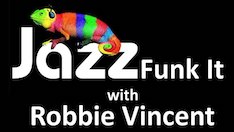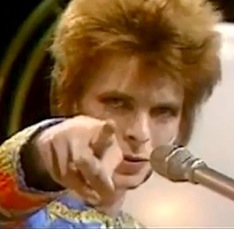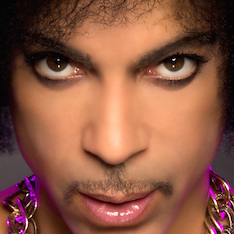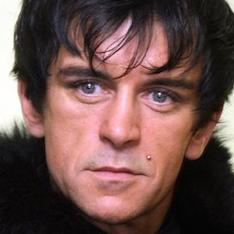Why them? Why then?

1978, the outsiders gather at Rusty Egan’s Heroes club-night at Billy’s in Soho: here, Peter ‘Marilyn’ Robinson, Julia Fodor, George O’Dowd. Photographed by Nicola Tyson
◼ BY 1979 THE ANGER OF THE BRITISH PUNK movement’s failed misfits was a pile of cold cinders. A monumental recession threatened school-leavers and even graduates with the prospect of no jobs, seemingly for life… Yet from this black hole burst a British band whose pounding synthesised electro-pop was to define a glitzy new youth culture and change for ever the rhythm of UK pop charts from the RnB guitar to the bass and drum.

Greeters at the Blitz: George O’Dowd and Steve Strange. Picture © Andy Rosen
When my phone rang in January 1980, little did I realise its message meant: “Put out the cat. You’re coming to the party of your life.” Obi-Wan Kenobi spoke without pausing: “My name’s Steve Strange and I run a club called the Blitz on Tuesdays and I’m starting a cabaret night on Thursdays with a really great new band they combine synthesised dance music for the future with vocals akin to Sinatra they’re called Spandau Ballet and they’re going to be really big…”
How could I know, as I stepped through the keyhole into a netherworld of impossible trendiness, that this was…
MY INVITATION TO THE SWINGING EIGHTIES

Easter 1980 at Steve Strange’s Blitz club-night: Julia Fodor leads Jennifer Binnie and sister Christine (“Miss Binnie” the artist), both clad in sackcloth, in their first performance piece at the club. Fashionista Iain R Webb sacrifices himself on the cross. Photographed by Homer Sykes
Daily life would never sound or feel the same again. One band defined a new direction for pop and shifted its driving rhythm, from the rock guitar to the bass and drum. They also made it hip to play pop. They were Spandau Ballet who burst as dandies from a sexually ambivalent London club-night called the Blitz. After only eight live shows they were in the UK pop charts. Within three years they went from leaders of a cult to being one of four British supergroups (with Duran Duran, Culture Club and Wham!) who swore death to rock and roll, and led a total of 108 stylish young clubland acts into the UK charts – more than ever sprang from the Liverpool of the Sixties – among them ABC, Depeche Mode, Soft Cell, Bananarama, Human League, Sade, Haircut 100.

July 1980: For the house band of the Blitz club, Spandau Ballet, image was as important as the music. Here we see Martin Kemp and Tony Hadley during a rare performance aboard HMS Belfast to an invitation audience of New Romantics. Photographed by Virginia Turbett

The Blitz: Crucible for change
A NATION’S JOURNEY
This site, Shapers of the 80s, revisits the early Eighties through the journalism and photography of one observer who knew a good time when he saw one and wrote about it in the London Evening Standard and, as the subcultural slipstream created new publications, also in The Face and New Sounds New Styles, among others. The preposterous people you will find within these pages are the key players whose energies transformed British youth culture during an extraordinary journey by the whole nation from one of makers to another of servants as Britain found a new role for itself in the affluent Eighties.
“ Rules were broken: men wore makeup, feminine clothes, it was costume. . . Women experimented in getting rid of those codes that existed in discos which were men looking like men and being on the pull and being predatory and girls waiting to be pulled. That went right out the window ” – Caryn Franklin, writer, broadcaster
THE TEAM WHO TRIGGERED
A NIGHTLIFE REVOLUTION
◼THE ONE-OFF CLUB NIGHT was pioneered in 1978 by Rich Kids drummer Rusty Egan. He printed a flyer declaring “fame fame fame” to lure Bowie outcasts to the un-punk safety of a tacky gay dive called Billy’s, in Soho. In common with London’s posher clubs, Tuesdays there were a dead zone. “I’ll fill it for you,” said Egan, establishing the principle of bar profits to the club owner, door profits to the hosts. This initially meant David Claridge vetting the door, but he soon gave way to Egan’s flatmate, pop wannabe Steve Strange, another Welsh graduate of the UK soul circuit who worked at the flouncy clothes shop PX which came to fix the New Romantic look. By February 1979, the axis of Strange as greeter and Egan as deejay had set a template for the next chapter in London nightlife: the once-a-week party that enjoyed full disco facilities. The duo marched into Covent Garden and nailed their ambitions to the Blitz club.

Regular faces at Billy’s 1978: all it took was a crucial accessory, a pert forage cap, a tossed hair salad. Presto! Instant glamour. Far left Charles. In white jacket Andy and behind him Steve Strange. Beside him Billy and Jane at extreme right. (Photo © Sheila Rock)

Space-cadets at Billy’s 1978: greeter Steve Strange with Helen Robinson whose PX boutique became the source for New Romantic fashions. (Photo: Nicola Tyson)
➢ Elsewhere at Shapers of the 80s: Who are the New Romantics?
➢ Elsewhere at Shapers of the 80s: Who’s Who in the Pits – Harry Cool’s Guide to the New Glitterati
☐ ☐ ☐
Defining the Swinging Eighties
◼ “IF WE RECAST THE 80S as a subcultural timeline, the decade actually spanned six years. They began in June 1978 when David Bowie’s world tour hit the UK – rallying dispossessed punks and kindred music-loving nomads who came to recognise they were not alone.
“These Eighties ended in Dec 1984 with what remained for 13 years the biggest-selling single in UK chart history, Do They Know It’s Christmas? This was an unprecedented act of charity through collaboration by 47 members of rival bands calling themselves Band Aid, who had risen on the same post-punk wave. They raised millions for the Ethiopian famine.
“Crucially, it confirmed a new British pop establishment of musical innovators. And coincidentally, it laid the foundations for Live Aid, the globally mounted fund-raising concert held in July 1985 and watched by 400 million viewers, across 60 countries.”
➢ Extracted from The Blitz Kids and the
birth of the New Romantics
RANDOM! ➢ Click here to visit a different random item at Shapersofthe80s every time you click
TAGS – Blitz Kids, New Romantics, Billy’s club, Steve Strange, Rusty Egan, Swinging 80s, London, nightlife, clubbing, pop music, video, recession, Band Aid, Spandau Ballet, Duran Duran, Culture Club , Wham!, youth culture, Band Aid










Pingback: David Bowie: First anniversary of his death and my teenage love is undimmed – apolarisview